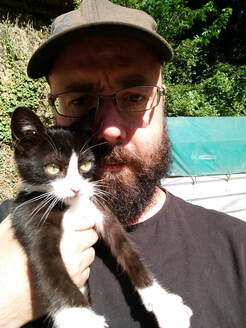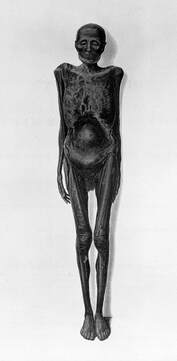|
Dr Gabriel Moshenska is a Senior Lecturer at the Institute of Archaeology, University College London. Interview with Dr Amara Thornton, IoA History of Archaeology Network Coordinator. AT: How would you define history of archaeology? GM: I think there’s different ways of approaching this question. There’s no single history of archaeology, just as there is no one best approach to its study. I’m particularly fascinated by biographical approaches – individual, group, and object-focused biographies. History of archaeology can rise up from the grassroots – sites, artefacts, archives, balance sheets, individuals, institutions – or it can descend from the clouds of theory, and trace concepts and models onto the crooked timber of archaeological humanity. I like the diversity of it, even if I’m rather unimpressed with quite a lot of the work that takes place within that diversity. AT: What is your area of research in the history of archaeology? GM: Primarily, I’m engaged in a biographical study of Thomas Pettigrew, the surgeon-antiquarian who became well known for holding public unrollings of Egyptian mummies. I’m assembling his intellectual biography in fragments, and currently looking at his work as librarian to the Duke of Sussex, and the liberal political milieus that this brought him into contact with. I have other strands of interest as well – perhaps too many – including the history of archaeology in London, from Charles Roach Smith through to the present. Through my Pettigrew work I’ve become very interested in the early history of the British Archaeological Association, and the rise of archaeology as a bourgeois pastime in the mid-nineteenth century. Most recently I did some work looking at the history of protest movements at archaeological excavations, and the nature of public ‘save the heritage’ campaigns, that often come to regard archaeologists as their enemies. AT: How did you become interested in the history of archaeology?
GM: During my PhD I became very interested in the epistemological significance of eye-witnessing in archaeology, and the role of expert and amateur audiences at excavations. This led me into historical studies of public archaeology, including Pettigrew’s mummy unrollings. Then I started working on archived correspondence of archaeologists and antiquarians, and there was no going back. AT: Are you working on anything in particular related to the history of archaeology right now? A long-overdue book! I’m also wrangling with the late Peter Gathercole’s research notes on Gordon Childe, which contain a wealth of fascinating material. Related to this, lately I’ve been enjoying Katie Meheux’s penetrating and illuminating work on Childe. AT: What, from your experience, is the most exciting thing you've come across in history of archaeology research and why? Correspondence between two antiquarians – Robert Lemon and Thomas Pettigrew – from 1826. Lemon reported to Pettigrew that he’d discovered a long-lost theological work by John Milton in the State Paper Office. Knowing sod-all about Milton, and having no wifi in the British Library manuscript room at that point, my first thought was blimey, what a discovery! Does anybody know about this? Fortunately the existence of De Doctrina Christiana is well known, but I was able to add a few details to the history of its rediscovery and attempts to variously authenticate and debunk it, and publish a short paper in Milton Quarterly. AT: Do you have any favourite books (academic or popular) related to the history of archaeology? GM: I very much enjoyed From Genesis to Prehistory, Peter Rowley-Conwy’s book on the contested reception of the three age system, it struck a lovely balance between the big ideas and the people behind them, and it was very well written. Philippa Levine’s The Amateur and the Professional is a book I return to again and again in my work, with ever growing appreciation for its breadth of understanding of Victorian antiquarianism. In terms of fascinating subject matter and superlative prose, The Master Plan, Heather Pringle’s study of Nazi archaeology, is unmatched. I highly recommend it to all archaeologists, particularly those naïve fantasists who cling to the idea of an ideology-free science of archaeology. AT: Is there a key object/ image/ text from an archive that inspires you or that you keep revisiting? GM: One of the strangest episodes in Thomas Pettigrew’s career was his mummification of the tenth Duke of Hamilton in 1852. Pettigrew carried out the embalming in the traditional Ancient Egyptian manner, and conducted a full faux-Egyptian funeral service, after which the Duke’s remains were interred in a genuine Egyptian sarcophagus. I read a letter from the Duke’s valet to Pettigrew in the Beinecke Library that said (I’m paraphrasing obviously) ‘The Duke just died, please come and bring the embalming spices’. I was and remain fascinated by the disparity between the outlandish strangeness of the event, and the banal matter-of-factness of the letter that heralded it. Thinking about this helps me keep the sense of wonder in my research, and a reminder not to feel too familiar or comfortable with the people and events that I’m studying. AT: Any advice for those interested in starting research on the history of archaeology? GM: There is so much still to do, so much incredible material lying untouched in archives. Don’t stick too closely to what’s been done before – blaze a new train through the sources and the ideas. And for god’s sake, read deeply in the historiography of science so you don’t make a fool of yourself. AT: From your perspective, what are the key issues in the history of archaeology right now? GM: The poverty of historiography. The huge amount of published research which is sub-antiquarian dross, boot-licking hagiography, or unoriginal piffles-about in stale secondary sources. We often talk about archaeology as a tool of European imperialism, but I think there’s a great deal more to be done looking at the details and operations of this mechanism. For example, I would love to know more about the roles of British archaeologists in colonial expeditions, invasions, and punitive raids. __ Follow Gabe on twitter at @GabeMoshenska or email him and ask for pdfs. |
Archives
June 2023
Categories
All
|


 RSS Feed
RSS Feed
